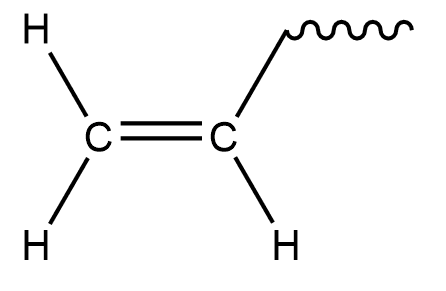
Which of the following is a vinyl group?
(A) \[\left( {{\text{C}}{{\text{H}}_3}} \right){\text{CH}} - \]
(B) \[{\text{HC}} \equiv {\text{C}} - \]
(C) \[{{\text{H}}_2}{\text{C}} = {\text{CH}} - {\text{C}}{{\text{H}}_2} - \]
(D) \[{\text{C}}{{\text{H}}_2} = {\text{CH}} - \]
Answer
213.9k+ views
Hint: We know that unsaturated hydrocarbons in which carbon atoms are bound to each other with double bonds are called alkenes. If one hydrogen atom from such compounds is removed, we can get a totally different compound.
Complete step by step answer:
Vinyl groups are also called ethenyl. It is basically ethylene with one less hydrogen atom less.
So, if we remove 1 Hydrogen from ethylene we get,

Hence \[{\text{C}}{{\text{H}}_2} = {\text{CH}} - \]is a vinyl group.
So, the correct option is D.
Additional information: Vinyl groups need to be activated by some other group for enhanced reactivity. Activation increases the polarity of the bond and hence also increases reactivity. Vinyl groups are often found as intermediates in preparation of various organic compounds. In hydrohalogenation of alkynes i.e. (addition of hydrogen and halogen) vinyl groups containing intermediates are formed. For example –
\[\begin{gathered}
{\text{H}} - {\text{C}} \equiv {\text{C}} - {\text{H + H}} - {\text{Br }} \to {\text{ [C}}{{\text{H}}_2} = {\text{CH}} - {\text{Br] }} \to {\text{ C}}{{\text{H}}_3} - {\text{CH}} - {\text{B}}{{\text{r}}_2} \\
{\text{ethyne vinyl bromide dibromo ethane}} \\
\end{gathered} \]
In the above reaction, when added to ethylene, vinyl intermediate is formed. Which on further reaction gives dibromo ethane. This reaction is used in preparation of secondary alkyl halides.
Vinyl groups are known to polymerize faster when a catalyst is used. Polymers formed are called vinyl polymers. However, these polymers do not contain any vinyl groups.
On industrial level manufacturing of polyvinyl chloride, vinyl chloride is used as a starting compound which contains vinyl groups.
Note: Out of the given four options, A is a tertiary butyl group and C option is an allylic group. Allylic group is often confused with vinyl group. We can remember it in a way that vinyl is formed when ethylene loses one hydrogen atom.
Complete step by step answer:
Vinyl groups are also called ethenyl. It is basically ethylene with one less hydrogen atom less.
So, if we remove 1 Hydrogen from ethylene we get,

Hence \[{\text{C}}{{\text{H}}_2} = {\text{CH}} - \]is a vinyl group.
So, the correct option is D.
Additional information: Vinyl groups need to be activated by some other group for enhanced reactivity. Activation increases the polarity of the bond and hence also increases reactivity. Vinyl groups are often found as intermediates in preparation of various organic compounds. In hydrohalogenation of alkynes i.e. (addition of hydrogen and halogen) vinyl groups containing intermediates are formed. For example –
\[\begin{gathered}
{\text{H}} - {\text{C}} \equiv {\text{C}} - {\text{H + H}} - {\text{Br }} \to {\text{ [C}}{{\text{H}}_2} = {\text{CH}} - {\text{Br] }} \to {\text{ C}}{{\text{H}}_3} - {\text{CH}} - {\text{B}}{{\text{r}}_2} \\
{\text{ethyne vinyl bromide dibromo ethane}} \\
\end{gathered} \]
In the above reaction, when added to ethylene, vinyl intermediate is formed. Which on further reaction gives dibromo ethane. This reaction is used in preparation of secondary alkyl halides.
Vinyl groups are known to polymerize faster when a catalyst is used. Polymers formed are called vinyl polymers. However, these polymers do not contain any vinyl groups.
On industrial level manufacturing of polyvinyl chloride, vinyl chloride is used as a starting compound which contains vinyl groups.
Note: Out of the given four options, A is a tertiary butyl group and C option is an allylic group. Allylic group is often confused with vinyl group. We can remember it in a way that vinyl is formed when ethylene loses one hydrogen atom.
Recently Updated Pages
Chemical Equation - Important Concepts and Tips for JEE

JEE Main 2022 (July 29th Shift 1) Chemistry Question Paper with Answer Key

Conduction, Transfer of Energy Important Concepts and Tips for JEE

JEE Analytical Method of Vector Addition Important Concepts and Tips

Atomic Size - Important Concepts and Tips for JEE

JEE Main 2022 (June 29th Shift 1) Maths Question Paper with Answer Key

Trending doubts
JEE Main 2026: Application Form Open, Exam Dates, Syllabus, Eligibility & Question Papers

JEE Main Correction Window 2026 Session 1 Dates Announced - Edit Form Details, Dates and Link

Equation of Trajectory in Projectile Motion: Derivation & Proof

JEE Main 2026 Application Login: Direct Link, Registration, Form Fill, and Steps

Hybridisation in Chemistry – Concept, Types & Applications

Angle of Deviation in a Prism – Formula, Diagram & Applications

Other Pages
NCERT Solutions For Class 12 Chemistry Chapter 1 Solutions - 2025-26

NCERT Solutions for Class 12 Chemistry Chapter Chapter 7 Alcohol Phenol and Ether

NCERT Solutions ForClass 12 Chemistry Chapter Chapter 8 Aldehydes Ketones And Carboxylic Acids

JEE Advanced Marks vs Ranks 2025: Understanding Category-wise Qualifying Marks and Previous Year Cut-offs

Haloalkanes and Haloarenes Class 12 Chemistry Chapter 6 CBSE Notes - 2025-26

Solutions Class 12 Chemistry Chapter 1 CBSE Notes - 2025-26




